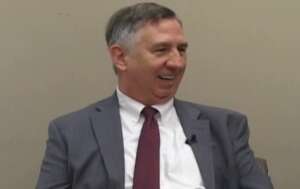
OPM’s new approach to modernizing retirement services is all about small bites
Guy Cavallo, the chief information officer for OPM, said the initial focus of the new retirement services system is on new retirees and starting them off in a d...
The third leg of the Office of Personnel Management’s strategy stool is about to drop.
OPM already issued an overall strategic plan that focused heavily on technology modernization. The second leg was the data strategy the agency released last month.
Guy Cavallo, the chief information officer for OPM, said the soon-to-be released IT strategy for fiscal 2023-2026 will complete the 18-month effort to remake the agency’s overall modernization plans.

“It’s not surprising that it’s going to focus on moving to the cloud, improving user experiences and complying with the cybersecurity directives,” Cavallo said in an interview with Federal News Network after speaking at the Emerging Technology and Innovation Conference sponsored by ACT-IAC. “To me, a lot of the executive orders that have been issued on cyber and customer experience are basically telling IT people to breathe. These are things that should be part of our DNA. We shouldn’t need an executive order to get people to totally change what they did, but it actually reinforces these things if they run into any resistance on why they’re doing it.”
Cavallo said he will post the IT strategy to OPM’s website when it’s finalized.
This will not be a typical IT strategy with goals to move to the cloud or rationalize applications. Rather, Cavallo said, it will build on the agency’s strategic plan released in 2022 and the data strategy released in March.
“We’ve listed out all of our IT strategies and directly tied them to what parts of the agency is reinventing itself. We really wanted to reinforce the business value that a particular modernization effort is bringing into a single application” he said. “It’s not just we’re going to the cloud because Guy wants us to get there. But this is the impact on retirees or this is the impact on citizens who want to get a federal job for the first time and don’t know where to start. I think when people see our IT strategy.”
As Cavallo highlighted, a key section of that IT strategy is fixing retirement services. This goal has been an albatross hanging around every OPM CIO and director’s neck over the past two decades.
OPM has tried time and again to improve the technology and processes around the retirement system, only to fall well short of expectations time and again.
Congress now is pressing OPM to address this long-standing problem.
Not fixing everything at once
Cavallo said he understands that past efforts have struggled, in part, because the agency tried a “big bang” approach to modernization. He said his strategy will be different.
“What I’m focused on is let’s get new retirees into a digital form so that we’re not trying to fix the entire past at the same time. Then, for the people that are already entered into the system, let’s bring that data into that same common customer experience so that our agents can find the status of a retiree in one place. Right now, they have to look in multiple places,” he said. “That’s not fixing everything at once. It’s starting to move toward a centralized common case management solution so that everyone has a case that can be looked up by the agent. Ideally, I’m hoping when we get to that point we’d be able to do is allow you to with the right, multi-factor authentication, have a bot look up your particular status.”
Cavallo added part of the initial goal is for current and future retirees to be able to look up their status easily, including how much money they will receive when the first check should be deposited after they retire and similar questions. Today, he said, those questions are too difficult to answer.
“The way I’ve been successful in my career is when you do something that’s a totally new process, you draw the line in the sand and say, ‘from this day forward, the next retiree is going to be in the new system.’ Because you’re still maintaining the legacy system, I’m trying to avoid the big bang of having to wait until all these various moving parts line up, and then throw a switch and hope it works,” he said. “I want to peel the onion and get the pieces to work separately. Then we’re not pulling the master switch at that point. We’re throwing a bunch of little switches in time, in order so that we can see the progress and make sure that we’re not jeopardizing anything. I think that’s what’s going to be different to my approach than what’s been done in the past.”
Part of the struggles of the past has been the technology wasn’t ready to handle the file sizes needed to process retirement claims. Cavallo said both the cloud and other advances in technology give OPM a new opportunity.
“If we’re going to build something new, I like to know if the product can handle if we have x million cases on it? Or is this going to break it?” he said. “The other thing I find that sometimes we don’t do well in government, is if you’re buying software-as a-service and you need licenses for each person, when the system is operational, you’re going to have X files and users using it, you better be figuring out what that cost is and planning for it in the future. I’ve seen too many people get sticker shock after an application has been built, and now they can’t afford the number of users.”
Chatbot, call center updates
In the short term, OPM has launched a chatbot and increased the number of call center agents to address the retirement backlog.
Cavallo said OPM is trying to improve the retiree experience sooner than how long it takes to launch new technology. He also moved the call center technology into the cloud to address too much downtime and frustrated retirees.
“What that has done is made it technology not be our point of contention, but how many agents do we have available to be able to answer a call in a decent period of time? One of the things I knew that we could do to help it is that we didn’t have a really good way to help retirees with questions and answers. Our website was difficult to follow. You had to read through a lot. So this is something that a chatbot should be able to answer when you type in a question. It could potentially relieve some amount of calls going into the call center,” he said. “We are working with the director to expand the number of call takers, but there’s a limit to how many times can you just keep increasing. We’re using the chatbot to see what type of questions are being asked that we don’t currently have an answer in the chatbot so that we can prioritize answering those questions.”
OPM will continue to add questions and answers to the chatbot over the course of the next few months as it better understands what questions users need answered.
“The most difficult part for us was you have people that have been at OPM 20-30-40 years that have great experiences, and sometimes we weren’t capturing the right person’s experience in the answer. If you talk to an agent, you might get a little different answer than the next one over. So something that I think has been very helpful out of this process as consolidating and giving everybody the single best answer to this question,” he said. “Then from there, we’re able to replicate that back to the call agents and in any of our training materials. It’s helping us retrain our call takers on better ways to answer questions than we’ve been answering it in the past.”
Copyright © 2024 Federal News Network. All rights reserved. This website is not intended for users located within the European Economic Area.
Jason Miller is executive editor of Federal News Network and directs news coverage on the people, policy and programs of the federal government.
Follow @jmillerWFED
Related Stories






